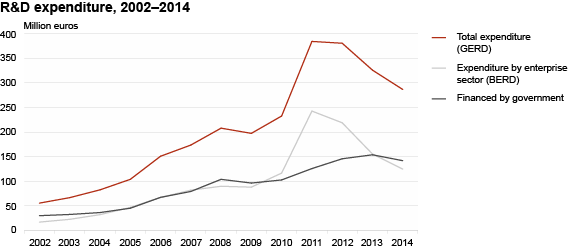Expenditure on research and development fell last year
According to Statistics Estonia, in 2014 the expenditure on research and development (R&D) in Estonia amounted to 286.7 million euros, which was 12% less than in 2013.
It was somewhat expected that in 2014, R&D expenditure remained on a downward trend as the large investments made in 2010–2012 to start the pilot project in the oil industry led to the exponential increase in total spending on R&D. In 2013, the pilot factory reached the production phase and the share of investments began to decrease. The impact of this was clearly recognizable in 2014.
In 2014, half of R&D expenditure in Estonia came from the State Budget. The share of R&D financing in the total general government expenditure was 1.87%.
The R&D expenditure in non-profit institutional sectors (higher education, government and non-profit private sectors) was 161.9 million euros, which was 5% less than in the previous year. This was mainly influenced by the higher education sector, where spending fell by 8% compared to the previous year.
The R&D expenditure in the business enterprise sector was 124.8 million euros, which accounted for 44% of the total R&D expenditure. Spending decreased by a fifth compared to the previous year mainly at the expense of investments. The share of investments in R&D expenditure in the business enterprise sector was 19%, which is the lowest in the recent years. This is influenced by the overall economic situation, where investment activity had started to decline already in 2013 and in 2014 business investments were a tenth smaller than in the year before.
R&D intensity i.e. the ratio of R&D expenditure to GDP was 1.44% in 2014, which meant a decrease of 0.28 percentage points compared to the previous year. According to Eurostat's preliminary data, Estonia did not fit into the top ten countries based on the R&D intensity index, but retained its position at the top of the following ten.Compared to 2013, the R&D personnel in non-profit institutional sectors increased from 7,517 to 7,562. Calculated in full-time equivalents (only by working time spent on R&D) the number of employees increased from 3,789 to 3,998. In full-time equivalents, R&D personnel were nearly half of the total, which means that almost every other person has been looking for extra work. In the business sector, R&D personnel also increased (from 2,767 to 2,930) while in full-time equivalents, the number fell from 2,069 to 1,798. R&D labour costs in the business enterprise sector remained at the same level as in the previous year.
